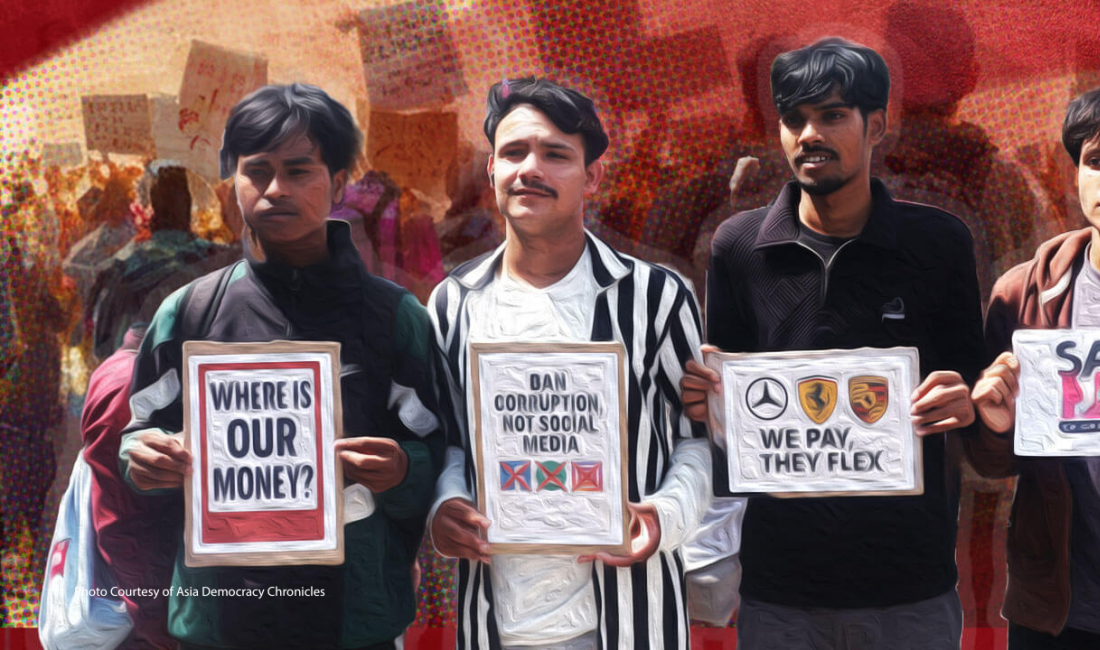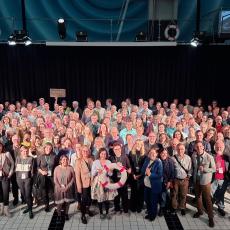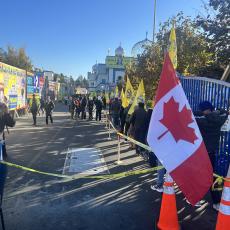2 Days to Topple a Government. 6 Months Til Election.
This story and the lead image were produced and published by Asia Democracy Chronicles
Sritama had a hard time sleeping, even though it looked like the worst was over. The riots that had raged through Nepal from the night of Sept. 8 until the next day had finally died down, and the country’s army had taken control of the streets.
Sritama, who, like other interviewees in this story, using only a first name requested a pseudonym, had been among the Generation Z protesters who had taken to the streets after the government banned 26 apps – practically the lifeline of the younger generation.
Yet even after Prime Minister KP Sharma Oli resigned on Sept. 9, many people remained on edge, fearful of what could happen next.
“Among many other anxieties, I was thinking, what if the monarchy was re-established?” confesses the 25-year-old Sritama to Asia Democracy Chronicles (ADC), recalling how she felt after Oli stepped down.
“As a generation, we have witnessed a lot and paid a fair amount of price for where we are historically now. Democracy is our blood and soul.”
Today, though, an interim government led by former Chief Justice Sushila Karki was in place, and elections have been announced to take place on March 5, 2026. Registration of voters is also being held until Nov. 16.
The Election Commission has stated as well that Nepali citizens who are over 16 years old can already register, although they may not cast a ballot until they turn 18. (The median age in Nepal, which has a population of 29.6 million, is 25.3 years.)
All these should be helping the likes of Sritama get a good night’s sleep. Yet many among Nepal’s Gen Z – those born between 1997 and 2012 – may now feel more restless than ever as much of the country expects them to follow through with what they started.
Indeed, their role in Nepal’s recent dramatic political upheaval is considered so significant that the army had asked Gen Z representatives for talks following the riots. Sritama also recounts a telling anecdote:
“My mother asked me unexpectedly, ‘Is Gen-Z the name of a political party in Nepal?’”
Matters would probably be simpler if that happened to be true, or if there was a political party that the youth considered their representative. That has yet to happen, however, although in the coming months, it may become imperative for Nepal’s Gen Z to come up with at least a common list of demands from the government that will be elected next year.
An ‘accidental’ revolution?
The truth is that while the protests have resulted in a profound political awakening among many of the country’s youth, the majority seem to have joined the Sept. 8 crowds near Parliament primarily to vent over the ban on the apps, which they saw as yet another form of suppression of an increasingly authoritarian government.
Then again, the growing callousness of the elite minority to the hardships of most Nepalis had also propelled several people, young and not so young alike, to join the rallyists.
Still, veteran journalist and Nepali Times publisher Kunda Dixit said in an interview with the U.S. magazine The Nation:
“Many people are asking, if the Gen Z group had stopped with its planned sit-in near Parliament, would all this have happened? Probably not. I think they’d have gone home, maybe there’d be a water cannon or two, and that’s it. But the massacre on Sept. 8, and the resulting anger and destruction that escalated the next day, that’s why we have this change now.”
A sudden surge in the crowd on Sept. 8 had apparently alarmed the police, who then fired shots; 19 of the young protesters were killed. Chaos ensued; later that night and for most of the next day, mobs rampaged throughout Kathmandu.
By the end of Sept. 9, they had burned Parliament and several state buildings, the homes of some government officials, including those of former ones, branches of a popular supermarket, and even a five-star hotel.
Some officials were also beaten up, among them the then foreign minister and her husband, a former premier. Aside from the protesters felled by police bullets, 55 more died as a result of the riots, while scores of others were injured.
The Gen Z protesters had quickly distanced themselves from the rioters, saying that their demonstrations had been infiltrated. Most Nepalis believe them and have their own suspects, but are reluctant to point fingers in public.
The anger among the young, however, has finally been acknowledged by authorities, who now say that they are ready to listen. And for the Gen Zs, it is about time that they did.
“Most of the time our generation is blamed that we have not seen ‘real struggle’ in the ‘real world’ as we are always online,” says Prathama.
“Though this might be partially true, we are not unaware of our surroundings and reality. This movement or protest is the sign that we are living in the real world and we care the most for our country and our people. Unemployed young people going to Gulf countries to earn a living – we care for them. The fact that we are always online does not mean we are unaware of the struggles and genuine challenges that cannot be ignored.”
In her first public comments as Interim Prime Minister, Karki was quoted in media reports as saying:
“We have to work according to the thinking of the Gen Z generation … What this group is demanding is an end to corruption, good governance, and economic equality. You and I have to be determined to fulfill that.”
The 73-year-old Karki, who had been among the protesters, emerged as Gen Z’s choice as Nepal’s interim leader after discussions, deliberations, and an informal online vote conducted on Discord.
Among those who had also been under consideration as the country’s temporary chief executive were former Nepal Electricity Authority chief Kulman Ghising, 54; Sudan Gurung, the 36-year-old head of the nonprofit Hami Nepal; and rapper turned Kathmandu mayor Balen Shah, 35.
Processing the Process
It was Gurung and Hami Nepal that had first issued a call for its Gen Z allies to head to the streets in protest after the ban on the 26 apps came into effect. The message spread so rapidly through social media and word of mouth that many of the protesters who turned up at the rally site near Parliament had no idea who had issued the call in the first place.
By then, too, other Gen Z groups had begun gathering their members to join the demonstration. When Hami Nepal later took the lead in talking to the military, some Gen Zs said that the nonprofit did not necessarily represent them.
Yet the organization, which aims to aid communities and individuals in need during emergencies, remains at the forefront of the youth movement that is determined to bring change to Nepal.
Gurung and Hami Nepal are now even supporting the notion of Shah possibly becoming the country’s next prime minister – a campaign that is gaining traction among many Nepali Gen Zs.
But some observers feel that in the rush to return to normalcy, other concerns are being shoved aside. Kavini, a young lawyer, says that while she understands the urgency to have elections, she nevertheless finds it hard to understand “why people are in a hurry to find the leader right here, right now.”
“It’s a process, a journey, to become a leader and get a leader,” she says. “Between all of this, the people who have lost their lives – nobody is talking about them that rigorously. The emotional part, the sensitivity of those fragile young lives, filled with thousands of dreams. No talks about the loss. The whole discourse has been shifted around the question, ‘Who will be your representative?’ And then every kind of person who has nothing to do with the Gen Z movement is going around saying they can be the one.”
There is more than some truth to what Kavini is saying. At the same time, however, it is crucial that the Gen Z movement maintain its momentum and not let the situation slide back to what it had fought against.
Already, the established political parties are regrouping, and while most of these have student wings, no one among the senior party stalwarts seems to be budging to make way for new blood.
That can only mean that for the Gen Zs to get the change they want through the ballot, they will need to come together and choose a strong representative, and probably form a new party altogether. Yet so far, there are no moves in that direction, from presumed frontrunner Shah or anyone else.
At the very least, the protests seem to have made many Gen Z Nepalis realize that even at their young age, they have the power to effect change. Several also now see the role of government – and their country — differently.
University student Asina says:
“Before this, I used to think my relationship with the government was very transactional: they give us high school leaving certificates, give us passports and citizenship cards, and take taxes from us. But now, even those not interested in politics before want to learn what an interim government is. How does it work? What is the president’s role in the Constitution? Now, youths who were not interested in politics are getting educated.”
Sritama, for her part, maintains that while she had joined the protests, she still has no political affiliation. But she says that she is “politically motivated.”
“The best thing about this protest,” Sritama also tells ADC, “is that (it made me) realize that I love my country this much.”



